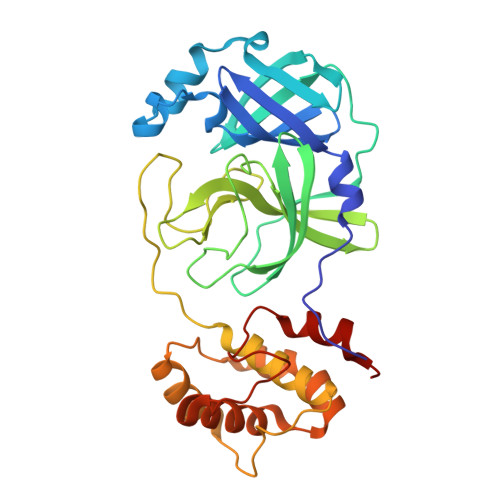Molecular mechanisms of drug resistance and compensation in SARS-CoV-2 main protease: the interplay between E166 and L50.
Zvornicanin, S.N., Shaqra, A.M., Flynn, J., Carias Martinez, H., Jia, W., Moquin, S., Dovala, D., Bolon, D.N., Kurt Yilmaz, N., Schiffer, C.A.(2025) mBio : e0406824-e0406824
- PubMed: 40183562
- DOI: https://doi.org/10.1128/mbio.04068-24
- Primary Citation of Related Structures:
9EL4, 9ELV, 9MEI - PubMed Abstract:
The SARS-CoV-2 main protease (M pro ) is essential for viral replication and is a primary target for COVID-19 antivirals. Direct-acting antivirals such as nirmatrelvir, the active component of Paxlovid, target the M pro active site to block viral polyprotein cleavage and thus replication. However, drug resistance mutations at the active site residue Glu166 (E166) have emerged during in vitro selection studies, raising concerns about the durability of current antiviral strategies. Here, we investigate the molecular basis of drug resistance conferred by E166A and E166V mutations against nirmatrelvir and the related PF-00835231, individually and in combination with the distal mutation L50F. We found that E166 mutations reduce nirmatrelvir potency by up to 3,000-fold while preserving substrate cleavage, with catalytic efficiency reduced by only up to twofold. This loss of catalytic efficiency was compensated for by the addition of L50F in the double-mutant variants. We have determined three cocrystal structures of the E166 variants (E166A, E166V, and E166V/L50F) bound to PF-00835231. Comparison of these structures with wild-type enzyme demonstrated that E166 is crucial for dimerization and for shaping the substrate-binding S1 pocket. Our findings highlight the mutability of E166, a prime site for resistance for inhibitors that leverage direct interactions with this position, and the potential emergence of highly resistant and active variants in combination with the compensatory mutation L50F. These insights support the design of inhibitors that target conserved protease features and avoid E166 side-chain interactions to minimize susceptibility to resistance. Drug resistance remains a great challenge to modern medicine. This study investigates SARS-CoV-2 main protease variants E166A and E166V which confer nirmatrelvir resistance. These variants can retain considerable enzymatic activity through combination with the compensatory mutation L50F. For single- and double-mutant variant enzymes, we assessed catalytic efficiency, measured loss in potency for nirmatrelvir and its analog PF-00835231, and cocrystallized with inhibitors to investigate drug resistance caused by these mutations. Our results contribute toward understanding of molecular mechanisms of resistance and combinations of mutations, which pushes toward resistance-thwarting inhibitor design. These principles also apply broadly to many quickly evolving drug targets in infectious diseases.
Organizational Affiliation:
Department of Biochemistry and Molecular Biotechnology, University of Massachusetts Chan Medical School, Worcester, Massachusetts, USA.


















